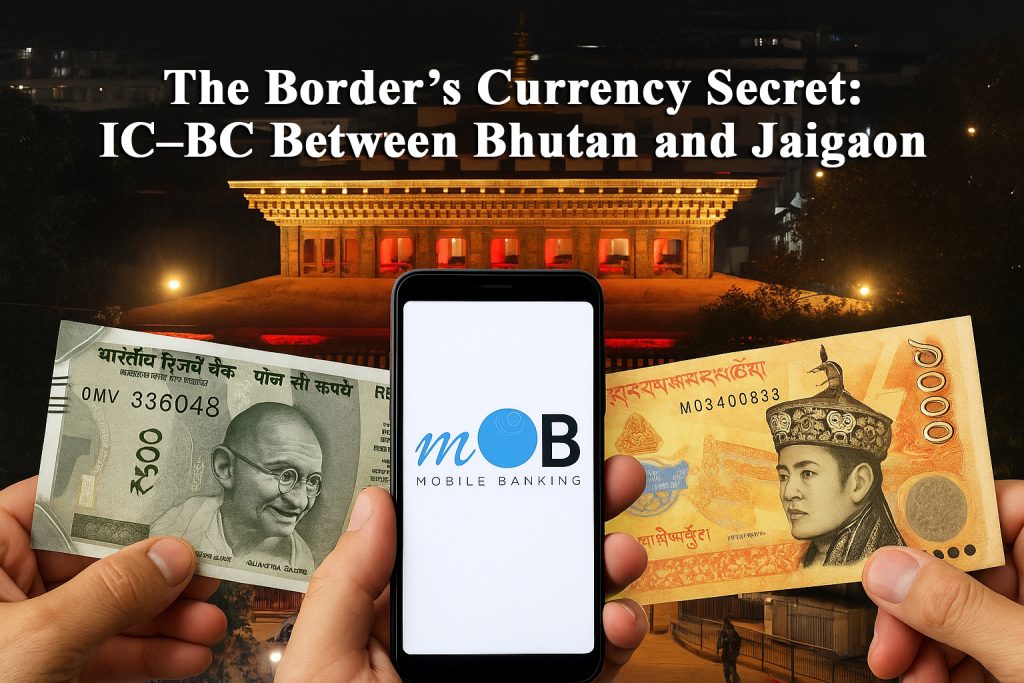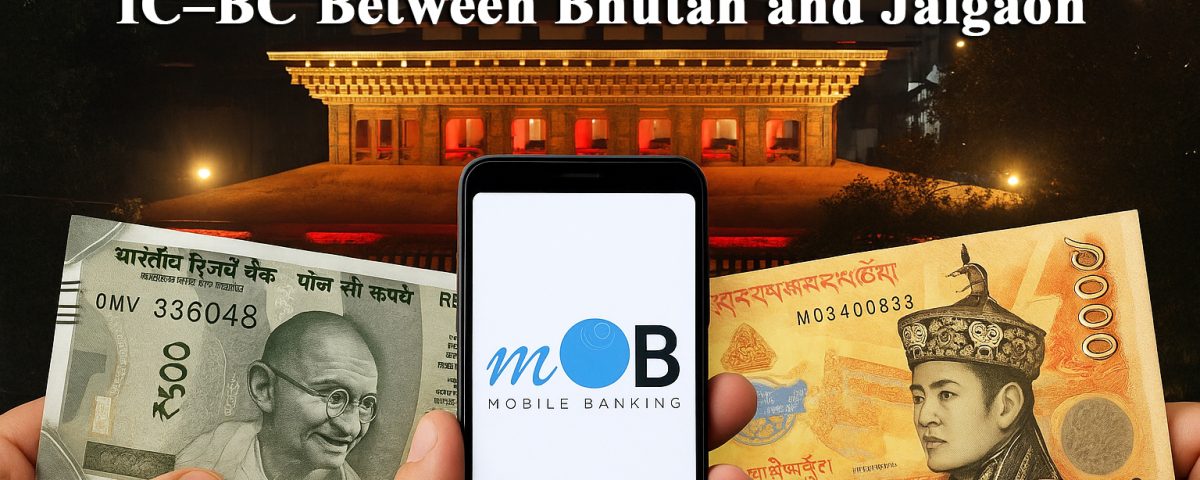
Editorial:
The Border’s Currency Secret: IC–BC Between Bhutan and Jaigaon
Behind the daily swap of Ngultrum and Rupee lies a shadow system of fronting, under-invoicing, and mobile wallet loopholes that keep liquidity flowing. What looks like a win-win arrangement actually raises deeper questions of accountability, unaccounted cash, and the darker risks of unregulated money movement.
A fragile monetary balance
For decades, the Indo–Bhutan border towns of Jaigaon and Phuentsholing have shared an unusual monetary relationship. The Bhutanese ngultrum (Nu), pegged at par with the Indian rupee (₹), should, in principle, be exchanged freely without friction. In practice, however, Jaigaon runs on its own rules, and the spread between ngultrum and rupee has become an indicator of liquidity, cash flow, and the hidden economy.
Today, the unofficial exchange rate carries only a 2% premium. Put simply, Nu 1,000 gets you ₹980, meaning an exchanger charges ₹1,020 for the swap. Compare this with the situation just three years ago, during and immediately after the COVID-19 lockdown, when the premium crossed 10% and sometimes touched 12–15%. This steep fall is not a minor fluctuation but a structural shift that reflects a sudden surplus of INR at Jaigaon.
Where do the rupees come from?
Several pipelines of cash explain this liquidity surge:
- Formal trade settlements: Imports into Bhutan are settled in INR, naturally injecting rupees into the banking system.
- Under-invoicing and non-declaration: At customs, consignments are often undervalued or not declared at all, leaving chunks of INR circulating outside official records.
- Fronting practices: Indian traders frequently use Bhutanese bank accounts through friends or employees. Payments for goods sold in Jaigaon are routed into these accounts. The Bhutanese account holder withdraws the cash in Phuentsholing and delivers it daily, keeping a commission.
- Digital conversion: Bhutanese buyers, armed with mobile wallets like mBoB, pay Indian shopkeepers by transferring into Bhutanese bank accounts. Later, either the account holder delivers the cash or Indian merchants withdraw from ATMs in Phuentsholing, again for a fee. This system has now become routine.
- GST-linked refunds: Perhaps the most lucrative pipeline. Border traders exploit GST returns and credits to generate extra cash flow. Goods under Indian GST slabs of 18–28% are often shown as exported only on paper, or deliberately overvalued and over-quantified. The inflated tax component forms the basis for large refund claims.
To complete such transactions, the importer, typically a Bhutanese trader, routes payment through Bhutan’s banking system into an Indian bank. Since the process is controlled from the Indian side, the Bhutanese partner bears no real risk. He merely facilitates the deal and pockets 2–5% of the GST component as commission.
Loopholes in the system
But here arises the critical question: How do such transactions slip past stringent checks? Import documents and consignments must be verified by Bhutanese Customs, regulatory departments, and clearing agents. Yet importers routinely bypass this supposedly concrete system. Who checks the documents, and who verifies the legitimacy of goods, remains under suspicion.
On the Indian side, Jaigaon’s Customs House Agents and officials further grease the system. For selected exporters, documents and consignments are cleared without inspection. This smooth passage comes at a price, lucrative commissions.
For instance, if a consignment worth ₹10 lakh is “exported” on paper, the IGST at 28% amounts to ₹2,80,000. By inflating invoices, this becomes the basis for hefty refunds. The masterminds behind these operations, real exporters, deliberately keep their identities hidden. They often register under obscure company names with addresses in Bihar or Delhi, making them difficult to trace in Jaigaon–Phuentsholing. These exporters pocket the lion’s share of profits, around 15–18% of the refund, while roughly 10% is distributed among Jaigaon customs, Bhutanese importers, clearing agents, and other intermediaries.
Each of these methods legal, semi-legal, or outright illegal, creates layers of liquidity that explain why Jaigaon no longer struggles for cash.
The win-win paradox
On the ground, these arrangements appear to be a win-win. Bhutanese buyers avoid the hassle of carrying INR, Indian shopkeepers secure liquidity, and Bhutanese account-holders earn easy commissions. Even government revenue officials tacitly accept it as long as business flows and complaints remain muted.
But the win-win comes at a steep cost: opacity, tax evasion, and an ever-growing volume of unaccounted cash. No official data tracks how much money circulates outside banks, but traders whisper that the sums easily run into crores every month.
Risks nobody wants to discuss
The buildup of untraceable rupees in a sensitive border zone is more than just an economic anomaly. It carries risks that policymakers hesitate to confront:
- Terror financing and organized crime: Unaccounted cash is a ready resource for anti-national networks.
- Political funding: Border towns, often fertile for rallies and pressure groups, are easily fueled by loose cash.
- Contraband and smuggling: From alcohol and tobacco to narcotics, informal currency circuits ease illicit trade.
- Counterfeiting and fraud: A cash-heavy informal economy inevitably attracts counterfeit networks.
When such large sums flow without oversight, they rarely remain confined to cross-border shopping.
What this means for policy
The narrowing exchange premium should not lull regulators into complacency. On the contrary, it signals that informal channels are working far too efficiently. If Jaigaon’s streets are flush with cash while formal banking systems report strain, it means the black economy has perfected its workaround.
A serious policy response requires:
- Crackdowns on fronting and proxy accounts in Bhutanese banks.
- Transparent, government backed exchange counters with published rates.
- UPI Bhutan wallet interoperability to cut reliance on informal swaps.
- Joint monitoring by the Royal Monetary Authority of Bhutan, Indian Customs, and enforcement agencies on suspicious INR movements.
The bottom line
The shrinking premium may look like good news for traders, but beneath the surface runs a river of untraceable rupees. This river enriches some, lubricates trade for many, but risks flooding the border economy with black money. Left unchecked, it could spill into channels that destabilize not only the economy but also the region’s security fabric.
Jaigaon today may look like a marketplace. Tomorrow, without corrective action, it risks becoming a laundromat of cash with consequences too grave to ignore.
***





